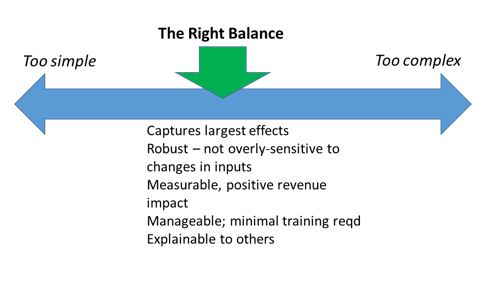Simplicity vs complexity: finding the right balance in airline RM
There are common pitfalls in how big data analytics can be applied to travel. Tom Bacon takes a look
In many industries often the use of big data analytics can be misapplied and the same applies to travel. Why? Because as big data expands and models become more and more sophisticated, there is a danger that companies oversimplify – or, alternatively, over-complicate – customer behaviour.
-
Over-simplification
One example of over-simplification is ‘last click attribution’. Attributing sales success to ‘last click’ ignores the fact that travel booking is a series of steps and that the driving factor may occur before the ‘last click’. Many analytics teams are analysing bookings based on a more complex decision-making process than just ‘last click’. Teams may be able to statistically identify the key clicks (sites that predict ultimate booking) or key patterns (combinations of sites) are often better predictors than ‘last click’.
Many relationships in the real world are non-linear so a linear model, that fits the historic period, can dramatically miss the forecast
Similarly, simple regressions often don’t fit the real world. Many relationships in the real world are non-linear so a linear model, that fits the historic period, can dramatically miss the forecast when the explanatory variable moves out of a narrow range. Also, certain variables may appear correlated but are not causal -- in many cases, factors are found to be correlated over a historical period but are not actually predictive. Finally, as in ‘last click attribution’ there may be a series of steps, not one or two major ones, that are determinative of customer behavior.
‘Tortured’ data is often an outcome of such over-simplification. Tortured data is data that is forced to align with analyst expectations. ‘Numbers can say anything you want’. Basic regressions lack validity when too many possible explanatory variables are investigated simultaneously and when the analyst, only through dozens of iterations, ‘finds’ the right model. One airline analyst confided to me that his department had worked on a model for months striving to prove a simple hypothesis that, in the end, wasn’t there.
-
Over-complication
On the other hand, many RM models have gotten too complex. With various market changes over decades, RM models have been enhanced tremendously, including O&D revenue management, buy-up modules and elasticity, real-time revenue linkages, and automated competitive price monitors. Some enhancements promise 0.1% additional revenue – or $5 million annually for a $5 B carrier. Of course, this is still a huge amount – but if it is unmeasurable and ultimately unprovable, it is likely to be elusive. In fact, the additional complexity added to manage the new feature could easily offset any real value.
Complexity has many direct costs. Some RM departments, deploying the latest, most sophisticated, modules, find the systems require tremendous monitoring and maintenance; in fact, the most sophisticated systems often have hundreds of employees managing the models. Greater complexity, too, may translate into unintuitive results that invite inappropriate analyst intervention. Often, complexity - driven by trying to get another 0.1% - is not really robust. Often the models are highly sensitive and respond to small changes in the marketplace; but in a highly dynamic marketplace they may be changing too often; a more robust solution will be less sensitive but also more accurate over the course of a week or month.
Sometimes, it appears models are built for academicians or statisticians, not airline practitioners. Some modules, designed to address a particular pricing problem, offer an ‘optimised’ solution based on extensive statistical analysis but do not acknowledge that most RM analysts are not such expert statisticians.
Of course, the issue of complexity extends beyond the RM department itself. Pricing strategy is a fundamental part of airline commercial activity and requires coordination and support across the organisation. Policies that are ‘mysterious’, that cannot be explained to the CEO or to other functions, will often not gain the necessary support.
-
Striking a balance
The right RM system for a given airline strikes a balance between simplicity and complexity. Rather than automatically implementing the latest, most sophisticated system or enhancement, each airline must understand both its competitive situation and its ability to resource and manage the system appropriately.

Tom Bacon has 25 years experience in the airline business and today is an industry consultant in revenue optimisation. Questions? Contact Tom at tom.bacon@yahoo.com or visit his website http://makeairlineprofitssoar.wordpress.com/

